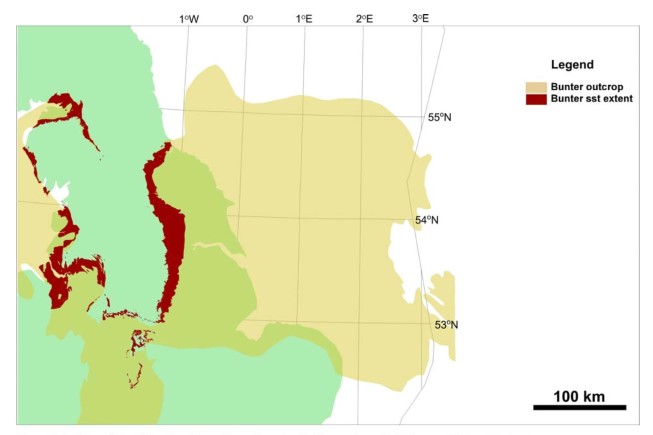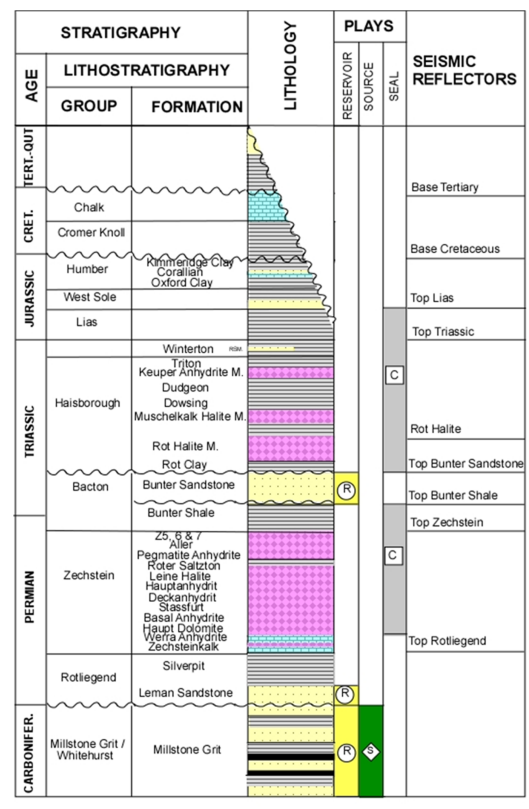Max Richards investigates
Max Richards, OPC’s International Business Manager (and part time in-organic CO2 geochemist) discusses some of the issues related to developing carbon storage projects in the UK sector of the SNS, largely the wide spread lack of data, of the Bunter Sandstone Formation, known onshore as the Sherwood Sandstone Group.
Max explains:
“My job as International Business Manager is working with our clients to understand and solve their problems, predominantly on a range of CO2 storage related projects, but my remit varies. OPC has been working intensely on various CO2 storage licenses in the UKCS and in this piece, I want to share some practices and data for the wider industry.”
A Brief Bunter History
The Bunter Group is regionally extensive in the subsurface, encapsulating the majority of the SNS, extending as far as 55 degrees north (similar latitude to the Lake District). It continues east from the coast of Norfolk to the Dutch sector, which extends onshore as far east as Poland, known as the Buntsandstein Formation.


The majority of SNS wells have penetrated the Lower Triassic Bunter. It is present above the main gas-bearing reservoir unit, the largely aeolian (Leman) Rotliegend Sandstone of the Lower Permian, separated by the Upper Permian Zechstein Group, and the lower Triassic Bunter Shale Formation.
The Haisborough Upper-Middle Triassic group, a proven seal, overlies the Bunter Sandstone. The Bunter is a proven gas reservoir across the SNS as a secondary reservoir, and in some cases, the primary, with fields Hewett, Indefatigable, Little Dotty, and Esmond having produced large volumes of hydrocarbons from the Bunter Group.
Renewed Interest – CO2 Storage
In 2023, the NSTA announced the first UK Carbon Storage Round, with results being announced in September. A total of fourteen companies have been awarded twenty-one licenses in depleted oil and gas reservoirs and saline aquifers. Fourteen of the twenty one licenses awarded are in the SNS, excluding the previously granted licenses CS001 (BP & Equinor’s Northern Endurance Partnership).
Within the SNS, en masse, two main carbon storage reservoirs are being evaluated: depleted gas fields (e.g., Hewett and Leman) and saline aquifers (Bunter Sandstone). The former is selected based on the logic that a natural gas resevoir likely means permanent storage of CO2. The Bunter Sandstone has many characteristics required for CO2 storage, including large, closed structures, good porosity and permeability, and a proven seal in the overlying Haisborough Group. However, the Bunter generally lack data, whereas natural gas reservoirs are highly appraised with a large amount of data available.
Herein lies an issue: saline aquifers are typically significantly larger than depleted gas fields and can store greater quantities of CO2. Furthermore, at the right depths, reservoir pressure is sufficient to inject CO2 in a supercritical/liquid form, where the pressure differential within the reservoir is not large enough to cause a phase change. This is to be avoided due to J/T cooling effects and other various injectivity issues, most depleted gas fields are below the critical co2 point, and thus injection must be done within the gas phase. However, due to a historical lack of commercial interest in saline aquifers, there is little or very sparse data available. Previous operators have largely not been interested in what was widely viewed an overburden in the way of hydrocarbon bearing reservoirs.
Many of the CCS projects in the SNS are targeting the development of both the depleted gas reservoirs and the overlying saline aquifer, the Bunter sandstone. Both have their own advantages and disadvantages. One of the issues with developing the Bunter as a CO2 store is the lack of data, and data 3000 ft below the seafloor is generally expensive to acquire. Typically, in most CCS projects, we would like to have a good grip on the fluid formation in the reservoir, which is very useful for evaluating injectivity, and core data to determine more accurate permeability and porosity measurements, which ideal for predicting fluid flow performance and relative permeability. The list goes on.
We would like to be able to evaluate potential CO2 stores using existing data to identify any major red flags or ‘show stoppers’ before spending large amounts of money on acquiring more data. As a part of the NSTA’s CO2 storage licence, license holders are required to submit an Early Risk Assessment before they can progress to the next phase.
Bunter Data
It has become apparent to OPC, who has several clients developing CCS projects in the UKCS, that finding as much data pertaining to the Bunter as possible could avoid potentially very expensive headaches in the future. We thought it wise to share some sources to the wider industry to support collaboration and encourage technical maturation of ideas.
The North Sea Wells Catalogue captured in the National Data Repository (NDR) has an enormous set of data, in fact, too big unless you know where to look. While most SNS wells penetrate the Bunter, few have cored, and even fewer have taken fluid samples. OPC has a list of wells with Bunter core and access to the available data; send us an email for this list and an outline of the dataset.
One worth mentioning is 42/24d-3, the original White Rose Carbon Storage appraisal well over the Endurance Bunter Closure (previously known as 5/42), drilled in 2013. The well dataset includes core, SCAL studies, wellsite geological report, injection well test, and much more. All of this information is available to the public.
Valuable UKCS studies include:
- Hewett conclusive report, which contains over 500 pages of assessment.
- BGS Storage Potential of the Bunter Sandstone
- White Rose Subsurface geoscience and production chemistry report
Various other studies and data exists. I thank those who contributed, including some of my previous colleagues!
OPC has worldwide CCS experience with experience in geological studies, reservoir simulation, injectivity analysis, and geochemistry. Contact us at london@opc.co.uk or Max Richards directly at max.richards@opc.co.uk
